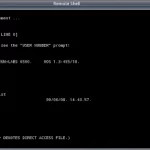Last Updated on: 5th November 2023, 05:12 pm
Web site: (not active)
Origin: USA
Category: Supercomputer
Desktop environment: CLI
Architecture: CDC 180 series
Based on: Kronos
Wikipedia: NOS/VE
Media: Install
The last version | Released: ? | May 2009
NOS/VE – a proprietary operating system of CDC in close relation to the well-renowned MULTICS operating system of MIT. It is a virtual memory operating system, employing the 64-bit virtual mode of the Cyber 960 as opposed to the 60-bit real memory mode (CDC 6600/7600 mode) used by the NOS operating system. Both systems run concurrently on a single CPU.
For customers using CDC software, CDC 180 machines booted into the old 170-mode operating system named NOS. This stood for Network Operating System–somewhat of a misnomer. From NOS, you could then boot CDC’s new 180-mode operating system, NOS/VE. VE stood for Virtual Environment; i.e., this OS used virtual memory. In 1985, NOS/VE wasn’t really ready for prime time, and I expect quite a few customers simply ran NOS and didn’t use the 180 mode of their machines at all. But I think it was possible–in fact, mandatory–to continue running NOS in the background after NOS/VE booted. NOS/VE, at least at this stage in its life (version 1.1.2), required NOS (then at version 2.4.1) to perform some I/O functions.
NOS/VE was a totally new operating system, written from the ground up in a new programming language. You’ve got to admire CDC’s gumption. The OS took some inspiration from NOS and from UNIX, which was becoming an important operating system, but in no way was NOS/VE supposed to be a clone of or even compatible with any other OS.
Unlike UNIX, and more like VAX/VMS, VE attempted to be a complex operating system with a lot of features built-in to the OS.
Regarding NOS/VE requiring NOS, Ken Hunter says this (in May 2007):
“This is kind of true, since there was no way to shut off NOS once NOS/VE was up. Also, to access NOS/VE from anywhere but the console, you needed NOS running because unit record and interactive I/O was done through NOS. I don’t think NOS/VE ever required NOS for disk I/O and paging, like Windows 3.x used DOS for this. It was also possible to boot NOS/VE from NOS/BE, and have unit record and interactive I/O go through NOS/BE. I’ve actually seen this done (but not at MSU). I’ve also seen NOS/BE hang after NOS/VE was boot, and NOS/VE kept running fine (sort of — I think I/O going through NOS/BE stopped). In theory, it should have been possible to boot NOS/VE from any 170 state OS, such as SCOPE/Hustler, but I don’t think things ever progressed that far at MSU. Dave Bright claims otherwise. If so, it was something he did which died when he left. I don’t remember ever seeing this run.
The problem was that the NOS/VE bootstrap PP for NOS/BE depended on and modified NOS/BE disk tables, which had a different format in SCOPE/Hustler.”
NOS/VE replaced the earlier NOS and NOS/BE operating systems of the 1970s.




We were (one of) the first running the NOS/BE – NOS/VE combi. More on our history at the computer history side of museumwaalsdorp.nl
Maybe it’s rose colored memories, but NOS/VE was the most elegant, consistent, programmer friendly OS I’ve ever used. The code I saw was beautiful; often self documenting. The Command Language was powerful, structured, and consistent. The whole thing was a joy for a programmer to use.
I am spoiled and dislike the current OSes I use (Linux, Windows, and Android) after the beauty of NOS/VE.